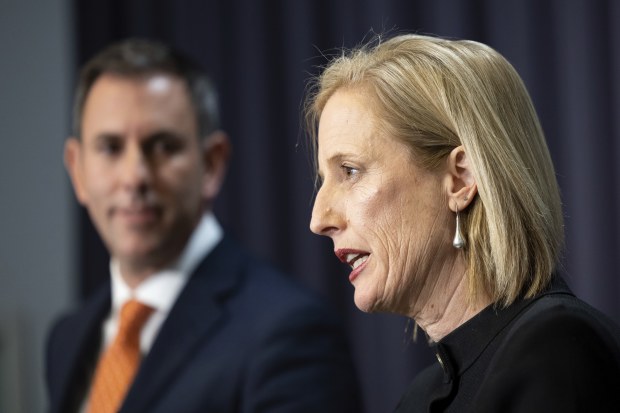Jim Chalmers goes after the wealthy and corporates in tax crackdown
The Albanese government will crack down harder on tax abuse by companies and the rich in an effort to raise at least $3 billion extra for the federal budget.
The Albanese government will crack down harder on tax abuse by companies and the rich in an effort to raise at least $3 billion extra for the federal budget.
Treasurer Jim Chalmers said the budget on Tuesday would include tougher tax compliance measures to be imposed by the Australian Taxation Office.
“There will also be in the budget some additional tax compliance measures in the field on programs began by our predecessors,” Dr Chalmers said in a pre-budget interview.

Jim Chalmers is looking for more revenue by cracking down on tax avoidance. AFR
The tax crackdown implements Labor’s election policy to collect a forecast $3.1 billionover four years by ramping up the ATO’s tax avoidance taskforce on multinationals, large corporates and wealthy individuals.
The Morrison government in the March budget extended the operation of the ATO tax avoidance taskforce by two years to June 30, 2025.
The taskforce was established in 2016 to undertake compliance activities targeting multinationals, large public and private groups, trusts and high wealth individuals.
Since being formed in 2016, the tax avoidance taskforce has helped the ATO raise $22.9 billion in tax liabilities and collect $12.7 billion, according to tax office figures.
In 2020-21 it raised $3 billion from public companies and multinationals, and $1.5 billion from privately owned and wealthy groups, including trusts and tax promoters.
“This revenue is used by the government to fund essential services, which may include education, health and other community services,” the ATO says.
Labor’s measure builds on the Coalition’s existing program.
Separately, Treasury is consulting on new laws for multinational companies operating across international borders.
“It will take a lot of time and effort to bed down our multinational changes,” Dr Chalmers said.
“We’re doing a heap of consultation on measures we took to the election and the OECD’s proposals.”
The new mulitnational tax laws are due to commence in July next year, which business has warned is an incredibly tight timeframe to get the details right.
The planned new laws will aim strengthen the interest limitation rules for multinationals, deny deductions for payments relating to intangibles and royalties, and enhance multinationals’ disclosure of tax information.
Miners, oil and gas producers and technology companies are among the multinational companies the government is targeting through proposed new laws.
The plan follows Rio Tinto settling a $1 billion dispute with the ATO over the use of an offshore marketing arm in Singapore, a similar structure that BHP was earlier penalised for.
The multinational measures were tipped by Labor before the election to raise an additional $1.9 billion.
Expert coverage of Australia’s public sector.
Sign up to the Inside Government newsletter.
No blank cheque’ for NDIS, Finance Minister warns as budget looms

Finance Minister Katy Gallagher says the Labor government must control spending on the $50-billion-a-year National Disability Insurance Scheme or public support for the program could be lost.
Senator Gallagher, who is responsible for the spending side of the Albanese government’s budget, said the cost of the program had grown much faster than expected, after the Coalition added $26 billion last December and Labor earmarked a further $8.8 billion over four years for Tuesday’s budget.

Finance Minister Katy Gallagher says the NDIS must be sustainable. Alex Ellinghausen
NDIS Minister Bill Shorten, a key architect of the scheme in the Gillard Labor government, last week launched a review of the NDIS, which is set to overtake Medicare as a spending item in the budget.
“That review is important because we need to make sure that people are assured that every dollar that is being spent there is going to what the NDIS is about, and it’s growing so fast that I think people will start to ask questions about it,” Senator Gallagher said in an interview with AFR Weekend.
“You don’t want people to lose support for it. It’s such an important social reform, but it’s like all of these things you can’t just have a blank cheque.”
Senator Gallagher said three of the big cost drivers were children remaining on the program rather than transitioning out as originally expected, autism among young people and people remaining on the NDIS after they turned 65 instead of moving into aged care.
One in three participants on the NDIS have autism, with 65 per cent of 7 to -to 14-year-old NDIS participants having autism.
Senator Gallagher has close ties to the disability community. She has previously publicly said she is blessed to have a daughter with autism, and she was minister for disability and community services in the Australian Capital Territory government before becoming chief minister.
Mr Shorten said last week many people coming onto the NDIS do not have “complex needs”.
“When this scheme was created, there was clearly unmet need,” he said.
“A lot of the people now coming to [the] scheme aren’t people who have the seven day a week 24 hour care needs.”
Treasurer Jim Chalmers said Labor would not “cleave tens of billions of dollars out of a scheme that we support”.
“It means getting maximum value for every dollar that we invest,” he said.
“We believe in the scheme. We think it’s a crucial way to support Australians with a disability.
“Our responsibility is to make it as sustainable as we can.”
Senator Gallagher compared the cost of the NDIS with Medicare, noting the number of participants it covered was vastly less.
As at June 2022, there were 534,655 NDIS participants, with the final annual financial sustainability report projecting this number to increase to 670,000 by June 2025 and almost 860,000 by June 2030.
Medicare partly subsidises the medical costs of 26 million Australians.
“It’s really assurance and making sure everything’s been done to manage the expenditure is actually going to the people who need it,” Senator Gallagher said.
She said making the NDIS more efficient did not necessarily mean reducing services to participants.
“Because we want people to have services, we want to make sure that they’ve been delivered in a cost-effective way,” Senator Gallagher said.
“The review is going to be the best assessment of that because there’s a lot of anecdotal chatter around what’s happening.
“The fact is it might be just quite different in operation to how it was originally intended.”
A decade ago, when the NDIS was conceived by the Gillard government and then implemented by the Abbott government in 2013, the Productivity Commission estimated it would cover 411,000 participants and cost $13.6 billion at maturity.
Now the total annual cost for the Commonwealth is about annual $29 billion and forecast by the government’s actuary to surpass $50 billion by 2025-26.
It is projected to hit $60 billion by 2030, though experts say there is a serious risk it could exceed that on the current trajectory.


